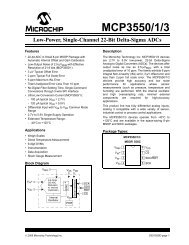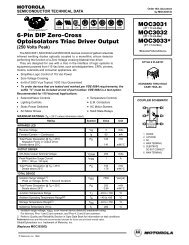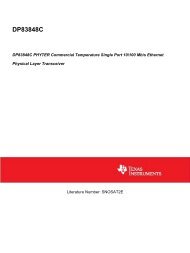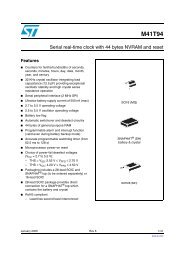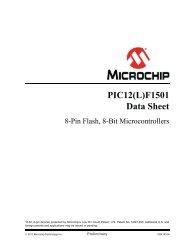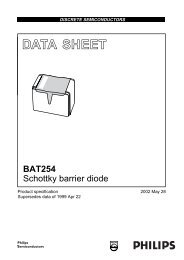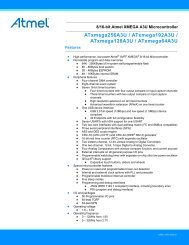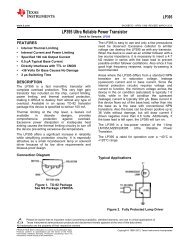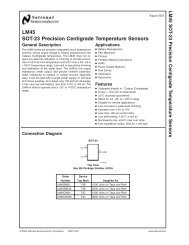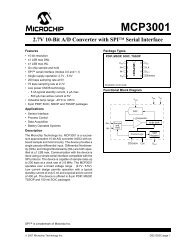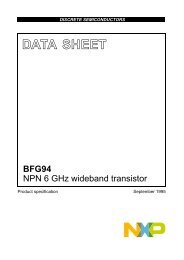MCP3421 - Microchip
MCP3421 - Microchip
MCP3421 - Microchip
You also want an ePaper? Increase the reach of your titles
YUMPU automatically turns print PDFs into web optimized ePapers that Google loves.
<strong>MCP3421</strong>If the configuration byte is read repeatedly by clockingcontinuously after reading the data bytes (i.e., after the5th byte in the 18-bit conversion mode), the state of theRDY bit indicates whether the device is ready with newconversion result. When the Master finds the RDY bit iscleared, it can send a not-acknowledge (NAK) bit anda stop bit to exit the current read operation and send anew read command for the latest conversion data.Once the conversion data has been read, the ready bittoggles to ‘1’ until the next new conversion data isready. The conversion data in the output register isoverwritten every time a new conversion is completed.Figure 5-3 and Figure 5-4 show the examples ofreading the conversion data. The user can rewrite theconfiguration byte any time for a new setting.Table 5-1 and Table 5-2 show the examples of theconfiguration bit operation.TABLE 5-1:WRITE CONFIGURATION BITSR/W O/C RDY Operation0 0 0 No effect if all other bits remainthe same - operation continueswith the previous settings0 0 1 Initiate One-Shot Conversion0 1 0 Initiate Continuous Conversion0 1 1 Initiate Continuous ConversionTABLE 5-2: READ CONFIGURATION BITSR/W O/C RDY Operation1 0 0 New conversion result in One-Shot conversion mode has justbeen read. The RDY bit remainslow until set by a new writecommand.1 0 1 One-Shot Conversion is inprogress. The conversion resultis not updated yet. The RDY bitstays high until the currentconversion is completed.1 1 0 New conversion result inContinuous Conversion modehas just been read. The RDY bitchanges to high after reading theconversion data.1 1 1 The conversion result inContinuous Conversion modewas already read. The next newconversion data is not ready. TheRDY bit stays high until a newconversion is completed.5.3 I 2 C Serial CommunicationsThe device communicates with Master(microcontroller) through a serial I 2 C (Inter-IntegratedCircuit) interface and support standard (100 kbits/sec),fast (400 kbits/sec) and high-speed (3.4 Mbits/sec)modes.Note: The High-Speed mode is notrecommended for V DD less than 2.7V.The serial I 2 C is a bidirectional 2-wire data buscommunication protocol using open-drain SCL andSDA lines.The device can only be addressed as a slave. Onceaddressed, it can receive configuration bits with a writecommand or transmit the latest conversion results witha read command. The serial clock pin (SCL) is an inputonly and the serial data pin (SDA) is bidirectional. TheMaster starts communication by sending a START bitand terminates the communication by sending a STOPbit. In read mode, the device releases the SDA lineafter receiving NAK and STOP bits.An example of a hardware connection diagram isshown in Figure 6-1. More details of the I 2 C buscharacteristic is described in Section 5.6 “I 2 C BusCharacteristics”.5.3.1 I 2 C DEVICE ADDRESSINGThe first byte after the START bit is always the addressbyte of the device, which includes the device code(4 bits), address bits (3 bits), and R/W bit. The devicecode of the <strong>MCP3421</strong> is 1101, which is programmed atthe factory. The device code is followed by threeaddress bits (A2, A1, A0) which are also programmedat the factory. The three address bits allow up to eight<strong>MCP3421</strong> devices on the same data bus line.The (R/W) bit determines if the Master device wants toread the conversion data or write to the Configurationregister. If the (R/W) bit is set (read mode), the deviceoutputs the conversion data in the following clocks. Ifthe (R/W) bit is cleared (write mode), the deviceexpects a configuration byte in the following clocks.When the device receives the correct address byte, itoutputs an acknowledge bit after the R/W bit.Figure 5-1 shows the address byte. Figure 5-2 throughFigure 5-4 show how to write the configuration registerbits and read the conversion results.© 2009 <strong>Microchip</strong> Technology Inc. DS22003E-page 17



